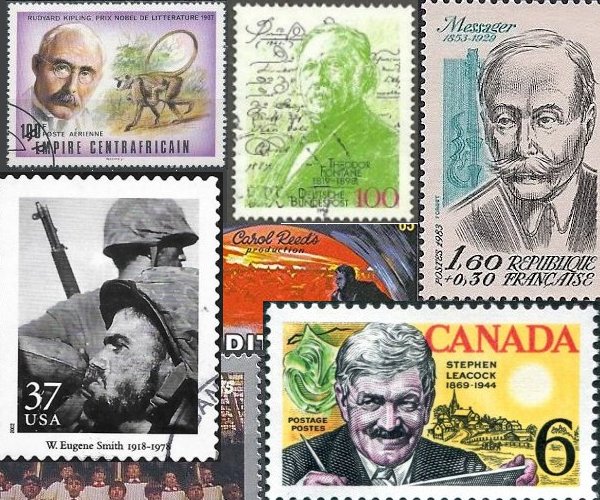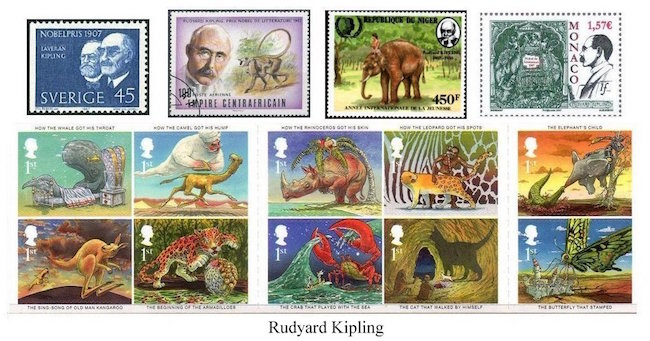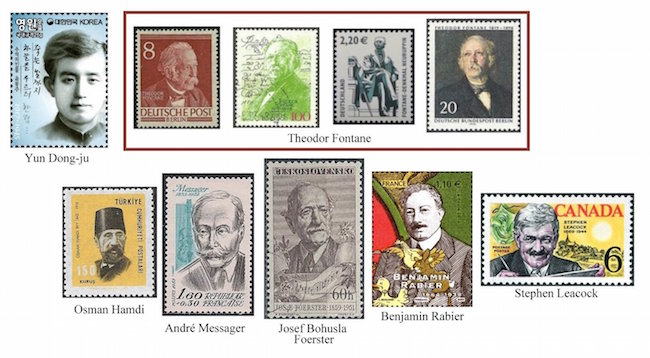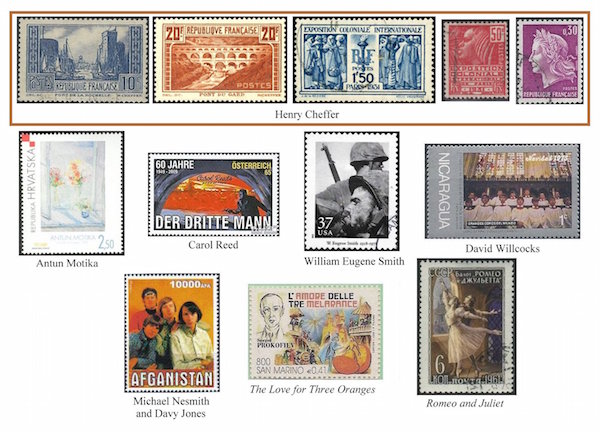The Arts on Stamps of the World — December 30
An Arts Fuse regular feature: the arts on stamps of the world.

By Doug Briscoe
Leading the parade today is Rudyard Kipling (1865 – 18 January 1936), whose works have inspired a number of musical compositions. Percy Grainger in particular set Kipling many times between 1898 and 1956. Charles Koechlin was also preoccupied with Kipling for many years; he wrote an arresting series of six orchestral pieces on The Jungle Book, some with vocal soloists and/or chorus, between 1896 and 1940. Kipling provided some poems for Kurt Weill’s Threepenny Opera. Bohuslav Martinů wrote a ballet on “The Butterfly That Stamped”, one of the Just So Stories. In 2002, the centenary of the publication of that book, Great Britain issued a picturesque set of stamps highlighting selected stories, “The Butterfly” being one (see at lower right). Other composers who have set Kipling include Edward Elgar, Edvard Grieg (!—a Norwegian translation of verse from the “Barrack-Room Ballads”), Frank Bridge, Granville Bantock, Edward German, Arthur Foote, Ethelbert Nevin, Charles Ives, Leo Ornstein, Healey Willan, and Ned Rorem. In addition, Michael Berkeley wrote an opera to a libretto by David Malouf, Baa Baa Black Sheep (1993), about Kipling’s boyhood.
Kipling’s name is doubtless more prominent, but the anniversary for Korean poet Yun Dong-ju (December 30, 1917 – February 16, 1945) is more significant, as today is his centennial. Born in China, he apparently did not set foot in Korea until his late teens, when he attended school there. From 1942 he was in Japan, studying English literature, but in the summer of 1943 he was arrested and charged with supporting the Korean independence movement. He died while incarcerated less than two years later at the age of 27. The posthumous publication of 31 of his poems as Sky, Wind, Star, and Poem (1948) received wide notice. A third edition in 1976 added many more poems and constitutes the bulk of his work. Just last year, a South Korean biopic, DongJu: The Portrait of a Poet, was released.
German poet, novelist, editor, and drama critic Theodor Fontane (1819 – 20 September 1898) was born north of Berlin and published his first novella, by all reports a weak piece that indicated no promise of greater things to come, in 1839. A few years later, in 1843, he joined a literary club that introduced him to such lights as Joseph von Eichendorff, Gottfried Keller, and Theodor Storm, and maybe something rubbed off. A decade later he was able to leave his work as an apothecary to become a full-time writer. In order to make the move work financially, he had to accept a job with the Prussian intelligence service, but they posted him to London, which suited the Anglophile Fontane very well. Back in Berlin he edited a conservative newspaper and then became drama critic for a liberal one. During the Franco-Prussian War, Fontane went to the front as a journalist and was captured by the French, of whom he was a guest for three months. It was only at the age of 57 that Fontane turned at last to the novel, the genre for which he is nest known today. Among the composers to have set his poetry have been Busoni, Hermann Goetz, Carl Loewe, Carl Reinecke, Joseph Marx, and Othmar Schoeck.

Ottoman painter Osman Hamdi Bey (1842 – 24 February 1910) was also an archaeologist and museum curator. He founded both the Istanbul Archaeology Museum and the Istanbul Academy of Fine Arts (now called the Mimar Sinan University of Fine Arts). As a student painter lived nine years in Paris, studying under Jean-Léon Gérôme and showing three paintings at the 1867 Universal Exposition. As director of the Imperial Museum he sponsored important archaeological digs and helped developed legal restrictions on the removal of artifacts from Turkey, laws that were emulated in other nations. The stamp is based on his Self-Portrait.
I used to think of André Messager (1853 – 24 February 1929) as a rather slight character, nothing more than a composer of inconsequential music, but I now know that this was a man of extraordinary energy and ability with a remarkable career of historic importance as conductor and administrator. Saint-Saëns was one of his teachers. When he was 21 he succeeded Fauré as choirmaster and organist at Saint-Sulpice under principal organist Charles-Marie Widor. Messager and Fauré became great friends and often traveled together, notably to see Wagner’s operas performed in Cologne and Munich and at Bayreuth. Fauré played the organ at Messager’s wedding, and the pair collaborated on at least two works. He had already written more than a dozen works for the stage when his opera Mirette was produced by Richard D’Oyly Carte in London in 1894. Written expressly for the occasion, it was the only original Savoy opera by any French composer. Messager turned down an offer to collaborate with W. S. Gilbert. Though quite prolific, with some thirty opéra comiques and operettas among his output, he wrote no new works for the stage between 1898 and 1914, when he was very active in other areas. He led the première of Charpentier’s Louise in 1900. He helped Debussy with the orchestration of Pelléas et Mélisande and led the première in 1902. (Debussy dedicated the opera to him.) He was a director of the Grand Opera Syndicate, which oversaw the Covent Garden opera seasons. He was joint director of the Paris Opéra and under those auspices gave the first complete Ring in Paris and the French première of Strauss’s Salome. From 1908 he conducted the Société des Concerts du Conservatoire orchestra, which during World War I he took on tour to Argentina, Switzerland, the U.S., and Canada. He did not yield when criticized for performing the music of Wagner and, with Fauré, eschewed the boycott of German music urged by the National League for the Defense of French Music, while at the same time (1915) contributing music (with such others as Debussy, Elgar, Mascagni, Paderewski, and Saint-Saëns) to King Albert’s Book to raise money for war-ravaged Belgium. He collaborated with Sacha Guitry in the 20s. He conducted the Paris premières of Auric‘s Les Fâcheux and Poulenc‘s Les Biches at the urging of Serge Diaghilev. He played a part in an important court case on copyright law in 1928. Along the way he had an affair with the Scottish soprano Mary Garden. Messager made a few recordings as a conductor in 1918, and his own music was recorded by such figures as Maggie Teyte, John McCormack, Aino Ackté, Emma Eames, Georges Thill, and Ninon Vallin. I borrow these words from Wikipedia: “…his fame as a composer of light music has tended to obscure his considerable standing in contemporary serious musical circles. The leading composers of the time valued his friendship and advice…In his native town of Montluçon, the new music academy, opened in 2009, is named the Conservatoire André Messager.” Besides his stage works, including ten ballets, he wrote two secular cantatas and a handful of instrumental works. There is even a symphony from his youth (1876).
We prolong the musical note. Josef Bohuslav Foerster (30 December 1859 – 29 May 1951) was born in Prague to a composer and conservatory professor (also Josef Foerster), one of whose students was Franz Lehár. The younger Foerster earned his living mostly from music criticism and teaching. While living in Hamburg he married the soprano Berta Lautererová and taught at the Hamburg Conservatory. In 1903 the couple moved to Vienna so that Berta could sing at the Hofoper. When the Czechoslovak Republic was founded after World War I, Foerster returned to the city of his birth and taught at the conservatory and the university. Until recently only a few of Foerster’s many compositions were represented on recordings, but now available on CD are at least two of his six operas (Eva and Debora), at least three of his five symphonies, both his violin concertos, all of his string quartets and piano trios, and numerous other works.

French illustrator Benjamin Rabier (1864 – 10 Cctober 1939) is more celebrated, if that’s the word for it, for an advertising image than for his work as a comic book artist and animator. He created the image for the brand of processed cheese The Laughing Cow (La vache qui rit) in 1924. France thanked him with a postage stamp in 2014. For some reason, Russian language Wikipedia has a huge article on him.
Born near Southampton, England, writer Stephen Leacock (30 December 1869 – 28 March 1944) was taken by his family to live in Ontario at the age of six. He did very well in school, top of his class, and was chosen as head boy. He began to teach even while continuing his education at the University of Toronto and saw his first writings published in a campus newspaper. Leacock was interested in political science and political economy and received a doctorate in those disciplines at the University of Chicago, where one of his teachers was Thorstein Veblen. But in the meanwhile he was writing humorous stories and other pieces for publication in Canadian and American magazines, and it was in this area that Leacock’s modern reputation rests, most of his political writing having fallen into obscurity. (On the other hand, his 1906 book Elements of Political Science was a standard college textbook for two decades and made him handsome profits.) By the year 1911 it was observed that “more people had heard of Stephen Leacock than had heard of Canada. Also, between the years 1915 and 1925, Leacock was the most popular humorist in the English-speaking world.” (Wikipedia). Leacock also wrote biographies of Mark Twain and Charles Dickens.
The French painter and engraver Henry Cheffer (1880 – 3 May 1957) designed images for banknotes and postage stamps for Belgium, Denmark, Luxembourg, Persia (as it was in those days), and Spain, along with a number for his native France. Among them are the 1929 pair for the port of La Rochelle and the Pont du Gard in Nîmes, the 1931 designs for the International Colonial Exposition (one of them showing the head of a Fachi woman from Niger), and one for a “Marianne” definitive that was made in 1954 but not actually used until 1967, ten years after the artist’s death.
Croatian painter Antun Motika (December 30, 1902 – February 13, 1992 ) set out studying sculpture and turned to painting, but in the early days earned his keep with caricatures contributed to periodicals and as a drawing teacher. He was able to present one-man exhibitions of his paintings in Zagreb in 1933 (and another in 1935). While teaching at the School of Applied Arts from 1940 to 1961, he experimented with various techniques and media: decalcomania, collage, photography, frottage, textiles, glass, moving lights, etc. His work appeared at the 1942 and 1952 Venice Biennale exhibits. These showings were followed by at least ten more solo exhibitions. One of his earlier pieces, Flowers on the Window of 1932, is offered on the Croatian stamp.
Live ‘n’ learn. I just found out to my surprise that English film director Sir Carol Reed (30 December 1906 – 25 April 1976) was the illegitimate son of Herbert Beerbohm Tree. Reed, who took his name from his mother, May Pinney Reed, quite naturally took to acting and joined the company of mystery writer Edgar Wallace, becoming his assistant in 1927. After Wallace’s death Reed went to work for the film industry. His first directorial efforts—Midshipman Easy (1935), Laburnum Grove (1936), The Stars Look Down (1940) with Michael Redgrave—won warm praise from Graham Greene, who was reviewing films for The Spectator in those days. It was Reed’s later efforts for which he became most celebrated: Odd Man Out (1947), The Fallen Idol (1948), The Third Man (1949), which is the subject of the Austrian stamp from 2009, and Oliver! (1968, one of the few musicals I can thoroughly enjoy), for which Reed won the Best Director Academy Award.
One of the photographers chosen for a 2002 USPS sheet devoted to Masters of American Photography was Wichita-born William Eugene Smith (December 30, 1918 – October 15, 1978). In New York he worked for Newsweek and Life, and he accompanied the Marines in World War II, capturing images at Saipan, Guam, Iwo Jima, and Okinawa, where he was wounded by mortar fire. It is one of the photos from this period that was selected for the stamp. Smith, a rather prickly sort of fellow, apparently, quit Newsweek because of the cameras they insisted he use and Life because they manipulated the pictures he had taken of Albert Schweitzer at Lambaréné. Later work of importance included Smith’s documentation of the city of Pittsburgh and a vast collection, not only of thousands of photos but also of thousands of hours of recordings, of jazz sessions between the years 1957 and 1965. (Jazz aficionados who don’t know it already will be thrilled to learn that this work, including material by Thelonious Monk, Bill Evans, Chick Corea, and hundreds more, is being restored, and some of it has already been presented on radio.)

The great choral conductor Sir David Willcocks (1919 – 17 September 2015) died just two years ago at the age of 95. There is no stamp for him per se, but a set of stamps commemorating choruses of the world issued by Nicaragua in 1975 includes the Choir of King’s College, Cambridge, which Sir David gloriously led from 1957 to 1974.
Did you know that Monkees members Michael Nesmith (b. 1942) and Davy Jones (1945 – 29 February 2012) shared this December 30th birthday? Another tidbit from the Funny Coincidence Dept. is that Jones played the Artful Dodger in some of the original stage productions of Oliver! opposite the late Ron Moody, who, of course, reprised his role of Fagin in Carol Reed’s film version. On the stamp (from Afghanistan!), Jones and Nesmith are seen at the front, with Micky Dolenz and Peter Tork in the rear.
Two Prokofiev premières took place on December 30, the opera The Love for Three Oranges in 1921 (at the Auditorium Theatre in Chicago!) and the complete ballet Romeo and Juliet in 1938 (at the Mahen Theatre in Brno). (Suites from the ballet had been heard earlier in Moscow and the United States.) The stamp for the latter comes from a group issued by the Soviet Union in honor of the Russian ballet in 1961-62.
The USPS has not yet seen fit to issue a stamp for American expatriate author and composer Paul Bowles (December 30, 1910 – November 18, 1999).
A graduate of the University of Massachusetts with a B.A. in English, Doug Briscoe worked in Boston classical music radio, at WCRB, WGBH, and WBUR, for about 25 years, beginning in 1977. He has the curious distinction of having succeeded Robert J. Lurtsema twice, first as host of WGBH’s weekday morning classical music program in 1993, then as host of the weekend program when Robert J.’s health failed in 2000. Doug also wrote liner notes for several of the late Gunther Schuller’s GM Recordings releases as well as program notes for the Boston Classical Orchestra. For the past few years he’s been posting a Facebook “blog” of classical music on stamps of the world, which has now been expanded to encompass all the arts for The Arts Fuse.
